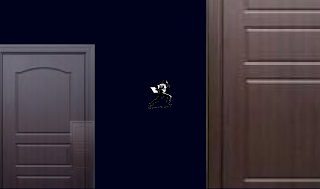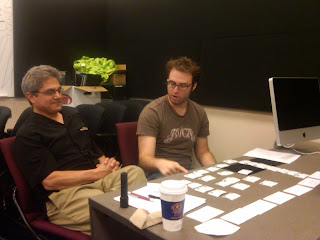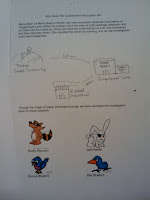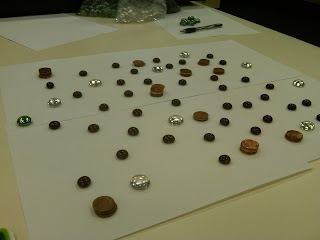The opening cinematic is audio played over a sequence of four images. Here's a breakdown of the script with descriptions of the images and references for them, intended specifically for Kelly, who'll be doing working on them.
Image 1
Fade up from black to show New Chicago from a distance. Chicago is a different city than it was at the turn of the century. It was badly damaged during a bombing campaign thirteen years ago, but has since been rebuilt. Downtown, lots of skyscrapers, connected at high levels by wide bridges. The wealthy live in the sky and get around on these thoroughfares, via horse-drawn carriage or automobile. Below them, and outside the downtown area, the poor live closer to ground level and travel mostly by cable car throughout the city. Everywhere, radio towers sprout from the architecture.
News Announcer: ...accident was caused by a loose wheel on the Army truck. Police expect the highway to be open by tomorrow morning’s rush hour. In other news, the mayor announced today that new restrictions on the Citizenship Passport System will go into effect immediately. Only holders of Level 7 clearance and above will be allowed within the downtown district after 5:45 p.m. Lower clearance levels will be subject to interrogation and incarceration.
Here's the real-world Chicago from a distance. I'm imagining something like this for the wide angle on the city -- like, an aerial view from this distance, or maybe a little closer. But I'm not sure that's best. If some other perspective seems better, run with it. We're really just trying to introduce the city as a character.
I'm including some other city shots that I like that are from different perspectives, mostly for style / atmosphere reference.

Image 2
Now we get closer, actually into the city. Nestled between mid-sized office buildings a single-lot “radio plaza” -- a miniature city park built around a public speaker tree which blares the official, national radio station twenty-four hours a day. There’s supposed to be grass around the concrete, but it isn’t very well taken care of. This is the sort of park where drug deals will be going down in a few hours. Maybe there are some kids loitering around a park bench. We can see, in one of the adjacent buildings, a single lit window looking over the park. There’s a woman’s silhouette in the window.
News Announcer: Unconfirmed reports of a death at NNWC are currently being investigated. A security officer has been murdered by a member of the Underground and police are closing in on the suspect as we speak.
I guess what I'm talking about is a "vest-pocket park," repurposed in this world to broadcast propaganda and news throughout the city.
I was imagining it from something like this kind of angle, too, although I found a good style reference photo that takes it in a very dramatic direction.
More reference images, just from a stylistic standpoint.
Image 3
Inside the office. Mills is standing at the window, smoking a cigarette and listening to the broadcast. Rick is at his desk, with his feet up, listening to nothing in particular. There's a cat on his desk -- maybe he's paying attention to her.
News Announcer: Dateline, Los Angeles -- Lewis B. Mayer, the top man at MGM has just had more sour luck. Only recently Mr. Mayer recovered from injuries after falling from a horse. Today, his machine tangled with a truck. One badly damaged ankle. In Mexico City, Peggy Fields, the ex-Follies Girl, will file for a Mexican divorce from A.C. Blumenthal. The Actress has settled for $135,000 net.
This is Rick's office. He's a Private Eye, so this is primarily a place of business. He's doing well enough, but it's not a fancy office or anything. Maybe a little small, but he's comfortable in it. Pretty bare, though. He don't have a lot of fashion sense.
I'm imagining the first image laid out kinda like this, with the two characters just sort of relaxing.
These are references for the sort / size of office I'm talking about, although these are maybe put together a little bit nicer than Rick's.
The phone rings over black.Rick: Yeah?Brief pause.Rick: Standard rate. Where? [...] OK.
Image 4
Same office, from a different angle this time. Mills is still standing by the window, but now she and Rick are looking at each other -- engaged in conversation.
Laid out more like this:

Rick: We’ve got a job.Mills: Finally. What’s the scuttlebutt?Rick: Something happened at NNWC.Mills: NNWC? As in, the station?Rick: Yeah.Mills: So there was a murder.Rick: Don’t know.Mills: Don’t know? You just accepted it without asking what type of job it was?Rick: They’re paying.Mills: Maybe we can spend the money on decorating your office.Rick: It’s fine.Mills: It’s dark, acrid, and smells like cat.Rick: We’re heading to the broadcast tower.Mills: Maybe some mirrors to lighten the room.Black.Radio Annoucer: We’ll continue after this commercial message from Arduina Vacuum Tubes.
That's the opening. Here's a little more detail on the characters.
Mills:
Rick:





























